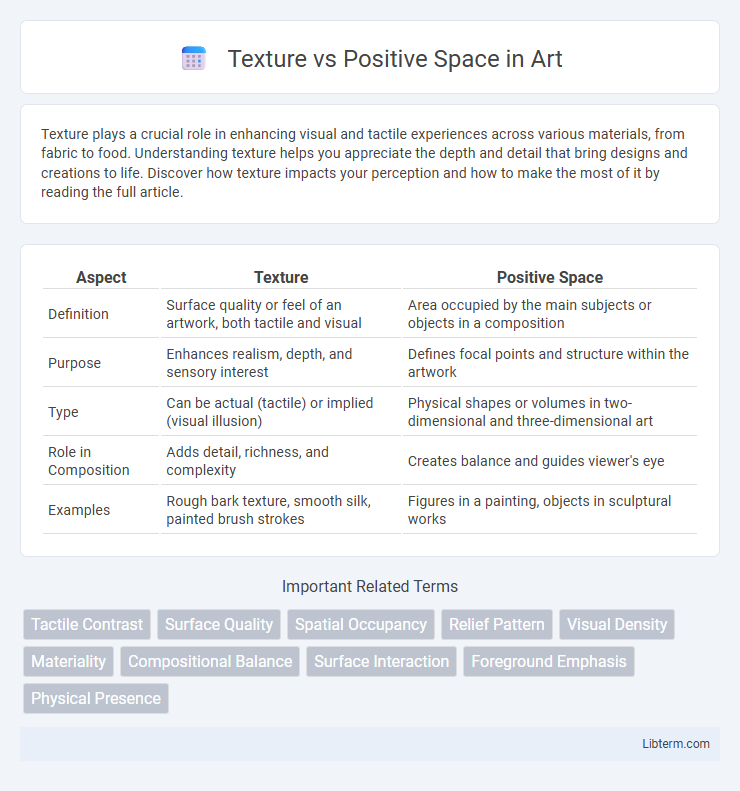Texture plays a crucial role in enhancing visual and tactile experiences across various materials, from fabric to food. Understanding texture helps you appreciate the depth and detail that bring designs and creations to life. Discover how texture impacts your perception and how to make the most of it by reading the full article.
Table of Comparison
| Aspect | Texture | Positive Space |
|---|---|---|
| Definition | Surface quality or feel of an artwork, both tactile and visual | Area occupied by the main subjects or objects in a composition |
| Purpose | Enhances realism, depth, and sensory interest | Defines focal points and structure within the artwork |
| Type | Can be actual (tactile) or implied (visual illusion) | Physical shapes or volumes in two-dimensional and three-dimensional art |
| Role in Composition | Adds detail, richness, and complexity | Creates balance and guides viewer's eye |
| Examples | Rough bark texture, smooth silk, painted brush strokes | Figures in a painting, objects in sculptural works |
Understanding Texture in Visual Composition
Texture in visual composition refers to the perceived surface quality or feel of an object within the artwork, achieved through patterns, shading, and brushstrokes that simulate tactile sensations. Understanding texture enhances the depth and realism of an image by creating contrast and engaging viewers' sensory perceptions. Positive space, defined as the area occupied by the main subjects, interacts with texture to establish balance and emphasize focal points in the composition.
Defining Positive Space in Art and Design
Positive space in art and design refers to the area occupied by the main subjects or elements within a composition, where texture enhances the tactile or visual qualities of these objects. Texture adds depth and richness to positive space, allowing viewers to perceive surfaces as rough, smooth, soft, or hard, thereby strengthening the overall impact of the focal elements. Understanding positive space is crucial for balancing composition and ensuring that texture contributes meaningfully to the viewer's interpretation of the artwork.
Key Differences Between Texture and Positive Space
Texture refers to the surface quality or feel of an object, often perceived visually or tactilely, while positive space denotes the main subject or area occupied by objects within a composition. Texture emphasizes how surfaces appear or feel, adding depth and interest, whereas positive space focuses on the actual shapes and forms that define the focal point of the artwork or design. Understanding the distinction between texture and positive space enhances the ability to create balanced and engaging visual compositions.
The Role of Texture in Enhancing Visual Appeal
Texture enhances the visual appeal by adding depth and dimension to positive space, making flat areas more engaging and tactile. It creates contrast and interest within the composition, drawing the viewer's eye to specific elements. Incorporating varied textures within positive space elevates the overall aesthetic by balancing smooth and rough surfaces, enriching the sensory experience.
Positive Space: Importance in Compositional Balance
Positive space plays a crucial role in compositional balance by defining the main subjects within a design or artwork, directing viewer attention effectively. It interacts with negative space to create harmony and structure, preventing visual clutter and enhancing clarity. Mastery of positive space arrangement ensures a cohesive and engaging visual narrative, essential for impactful composition.
How Texture Influences Perception of Positive Space
Texture enhances the perception of positive space by adding depth and dimension, making objects appear more tactile and realistic within a composition. Rough or intricate textures can draw attention and create focal points, increasing the visual weight of positive space elements. Smooth textures, in contrast, can simplify and expand positive space, allowing it to feel more open and less crowded.
Techniques for Combining Texture and Positive Space
Combining texture and positive space enhances visual depth by strategically applying varied surface qualities within defined areas of a composition. Techniques such as layering tactile materials or employing patterned brushstrokes within positive space boundaries create contrast and emphasis. Utilizing texture in conjunction with positive space guides viewers' focus while adding dimensionality and richness to the artwork.
Texture vs Positive Space in Different Art Forms
Texture and positive space play distinct roles across various art forms, influencing visual perception and emotional impact. In painting, texture enhances surface quality and depth, while positive space defines the main subjects, creating a balanced composition. In sculpture, texture adds tactile dimension to positive space, shaping form and inviting physical interaction, whereas graphic design uses texture subtly to emphasize positive space elements, ensuring clarity and focus.
Common Mistakes When Using Texture or Positive Space
Common mistakes when using texture or positive space include overloading a design with excessive textures, which can create visual clutter and reduce clarity. Misjudging the balance between positive space and negative space often leads to compositions that feel cramped or disorganized, diminishing the overall impact. Designers may also fail to consider how texture interacts with positive space, resulting in conflicting elements that confuse the viewer.
Best Practices for Harmonizing Texture and Positive Space
Balancing texture and positive space involves using texture to add depth without overwhelming the focal area, ensuring the positive space remains clear and purposeful to guide viewer attention. Employing subtle textures in background elements enhances visual interest while maintaining a clean and organized composition. Strategic placement and scale of textured elements contribute to a harmonious design that supports the overall message without sacrificing readability or spatial clarity.
Texture Infographic

 libterm.com
libterm.com